1800, U.S. Census: total population, 5.31 million; slaves, 894,000 (16.8%); free blacks, 108,000 (2.0%).
1800, Congress enacts stiff penalties for American citizens serving voluntarily on slave ships trading between two foreign countries. But enforcement is lax, convictions are very few.
 Gabriel Prosser.
Gabriel Prosser.
1800, Richmond, Petersburg and Norfolk are targets of insurrection as planned for Aug. 30 by enslaved blacksmith Gabriel Prosser. It fails when betrayed by other slaves; Virginia Gov. James Monroe (who was to be kidnapped under the plan) sends militia. Prosser, two brothers and 23 other slaves are hanged. Informing slaves are rewarded with freedom.
1800, Thomas Jefferson (Virginia) is elected president over incumbent John Adams (Massachusetts). The last state to vote (election days were staggered through the fall) is South Carolina, which breaks a tie in electoral votes with its eight going to Jefferson and Aaron Burr, Democrat-Republicans.
Note: If slaves were not counted at all in calculating electoral votes, Adams, the Federalist, would have won re-election.
The House actually has to determine final presidential winner between Jefferson and Burr under provisions of the time. In the end, New York’s support for Jefferson is decisive, determined by Alexander Hamilton’s deep dislike of Burr, Feb. 17, 1801.
1800, Average annual consumption of sugar per Briton is 18 pounds, up from four pounds in 1700.
1800s, As new waves of enslaved arrive in Americas in the century’s first half, syncretic African religions gain many adherents in Brazil’s Bahia (Candomblé), on Cuba (Santería) and in many other Caribbean colonies.
Vodou, which helps unify rebelling slaves in Saint-Domingue, gains strength after Haitian independence is declared. Vodou reflects religious beliefs of Fon people in Benin; Santería is based on Yoruba beliefs; and Candomblé is split into terreiros (temples) respectively devoted to Nagô (Yoruba), Jejé (Fon and Ewe people) and Angola (Bantu peoples).
African orixás (the deities who interact with adherents) are echoed by the Catholic saints in the view of many followers.
Maroon communities on Jamaica practice Kumfu, related to Akan (Gold Coast) traditions.
1801, Attempt in Congress to pass stronger Fugitive Slave law fails; similar effort in 1817 also fails.
 Fighting on the Mediterranean.
Fighting on the Mediterranean.
1801, Pres. Jefferson dispatches three frigates to Mediterranean, May 13, to end U.S. payments to Barbary states of Algiers, Tunis and Tripoli. Latter had long extorted tribute to hold back pirate attacks that previously resulted in seizure of American ships and cargo, and ransoming or enslavement of sailors.
Blockades, bombardments and raids (including destruction of USS Philadelphia after it fell into Tripolitan hands, Feb. 4, 1804) climax with U.S. capture of Derna in Cyrenaica, April 26, 1805, and end with freedom for Philadelphia crew (at much-reduced ransom) and cancelation of further tribute.
 Louverture presents constitution.
Louverture presents constitution.
1801, In Saint-Domingue, Louverture promulgates a constitution abolishing slavery and naming himself governor for life (while still maintaining ties to France). He takes control of lightly populated Spanish side of Hispaniola in name of France, July. All individuals throughout island are to be “equal, free and citizens of France.”
1801, Acts of Union draw Ireland into the new United Kingdom, bring 100 new Irish members into Parliament, Jan. 22. Most will support abolition of slave trade.
1802, Liverpool imports of U.S. cotton (most from the Sea Islands) exceed those of West Indies for the first time. Liverpool, long the leader in the slave trade, is now also the leader in landing raw cotton for the textile factories of Lancashire and Manchester.
1802, Peace of Amiens ends France’s Revolutionary Wars with Britain and others, March 27. In the Caribbean, Britain returns Martinique to France, but retains Trinidad (won from Spain). Treaty allows Napoléon to turn his attention to Saint-Domingue. Peace lasts only a year before Britain again declares war, May 18, 1803. Historians will label conflicts to follow “the Napoleonic Wars.”
1802, French plebiscite approves new constitution that makes Napoléon first consul for life, May 10. He quickly rescinds 1794 law abolishing slavery in French colonies, May 20. This affects only Saint-Domingue, Guadeloupe and Guiana, as slavery had not actually been ended in other colonies.

1802, On Guadeloupe, Louis Delgrès (a free-born, mixed-race officer) vows to fight to death against returning French and resumption of slavery.
Cornered at Matouba, May 28, he and 400 followers detonate gunpowder stores as French troops close in, choosing to die in order to kill as many of the latter as possible. A mixed-race maron woman, Solitude, survives bombing. Her hanging, Nov. 29, is delayed only until she gives birth. She remains a symbol of resistance to this day.
Slave imports are supposedly blocked by British occupation in 1810, by Sweden which takes over for three years, and finally by France when restored to control in 1816. But slavery continues on Guadeloupe itself until 1848.
 Ex-slaves win at Vertieres.
Ex-slaves win at Vertieres.
1802, To restore French authority over sugar-wealthy Saint-Domingue, Napoléon sends four French and one Spanish fleet with 31,000 fresh troops across Atlantic, February. Led by Gen. Charles Leclerc (married to Napoléon’s sister), they quickly occupy ports, towns and plantations on both ends of Hispaniola.
Louverture realizes he is Napoléon’s target and retreats into rough hills with his soldiers. His lieutenants, Dessalines and Christophe, return to rebels, with Dessalines victorious in month-long Battle of Crête-à-Pierrot, March 24.
Dessalines and Christophe flip again to the French side, and Louverture agrees to lay down arms when promised light terms, restoration of his French rank and house arrest.
Then yellow fever tears through French forces, killing 15,000 in only two months. News of Napoléon’s restoration of slavery on Guadeloupe reaches Saint-Domingue. Thousands of blacks and free people of color leave French forces again, as do Dessalines and Christophe, for the final time, October.
Through trickery, Leclerc sends Louverture to France. He is imprisoned in the mountain Château de Joux where he dies April 7, 1803.
But French forces in Saint-Domingue dwindle down to 8,000 disease-weakened men as British naval blockade intercepts convoys of reinforcements, food and munitions. Each side engages in massacres, with Leclerc killing 1,000 black troops he suspects of mutiny by dumping them from ships. A still-loyal black general is drowned with his family.
Fearing yellow fever, Leclerc takes refuge on Tortuga only to die of the disease Nov. 1. His wife, Napoléon’s sister Pauline, is by his side. Leclerc is replaced by Donatien-Marie-Joseph de Vimeur, vicomte de Rochambeau (and son of Washington’s ally at Yorktown).
1803, Ohio becomes the 17th state, March 1, and is free under Northwest Ordinance.
1803, Britain declares war on Napoléon, May 18, after only a year of peace. This eliminates possibility that Napoléon will attempt to rescue beleaguered French army in Saint-Domingue, which is soon surrounded by Royal Navy.
1803, Desperate to stave off defeat, Rochambeau seeks to terrorize Saint-Domingue rebels with 600 Cuban pit bulls trained to attack black people. French ultimately lose at Battle of Vertières, near Le Cap, at hand of Dessalines, Nov. 13. Rochambeau agrees to surrender to British fleet offshore. The remaining 7,000 French soldiers depart by mid-December, leaving behind their wounded, who are drowned by Dessalines’ men.
Rochambeau is taken prisoner by a blockading British frigate and is interned in England for nine years. French are thus finally defeated in Saint-Domingue by combined forces of ex-slaves and free people of color, with assistance from the Royal Navy in the final year.
1803, The yellow fever that decimated French troops in Saint-Domingue spreads east to Spanish city of Santo Domingo.
1803, Ships carry refugees—whites, free people of color and some still-enslaved blacks—from carnage in Saint-Domingue to Santiago de Cuba, where mixed-race people are threatened with enslavement under Spanish law. But other refugees are welcomed for their sugar-plantation and refining knowledge.
 Celebration of Louisiana Purchase.
Celebration of Louisiana Purchase.
1803, Louisiana Purchase gives U.S. control of New Orleans, Mississippi and Missouri rivers, and vastly expands U.S. territorial claims (although actual control remains in hands of scores of Indian tribes), signed April 30. Pres. Jefferson’s envoys, Robert Livingston and James Monroe, negotiate $15 million price with Napoléon, whose interest in America is fading, thanks to the bloody losses on Saint-Domingue and to his need for cash to support possible invasion of Britain.
Spain formally turns over upper Louisiana territory to France, March 9, 1804, in St. Louis. France turns it over to the U.S. March 10.
1803, Seventy-five Igbo slaves purchased in Savannah, GA, take control of coastal schooner carrying them to St. Simon’s Island plantations, May. They drown captors and submerge boat in creek. Seeing no possible escape as pursuers close in, they deliberately walk into swamp to drown rather than be re-enslaved; only a few are pulled out.
1803, First U.S. gold rush begins with reports of a 28-pound nugget found on North Carolina farm of John Reed, northwest of Charlotte. Stream mining superseded by lode mining on area’s small farms. Mining here drops off even before larger Georgia gold rush erupts in 1828.
1803, Denmark is first European nation to ban slave imports to its Caribbean colonies and exports from its Gold Coast factories (when a 1792 royal decree finally takes effect). But slavery itself continues in Danish West Indies (St. Thomas, St. John and St. Croix).

1804, New Jersey adopts gradual emancipation (20% of Bergen County population is still enslaved), the last Northern state to do so. Many people are sold to Southern plantations. Sixteen persons are still indentured until freed by 13th Amendment in 1865.
 Explorers begin their journey.
Explorers begin their journey.
1804, Lewis and Clark expedition travels up Missouri, over Rockies and down Snake and Columbia rivers to survey Louisiana Purchase. Party of 40-plus includes Clark’s black slave, York, and is assisted by Sacagawea, a 16-year-old Shoshone who translates and guides. Expedition returns to St. Louis, Sept. 23, 1806.
1804, In new state of Ohio, where slavery is forbidden by the Northwest Ordinance, legislature passes “Black Laws” restricting rights of free blacks. Every “black and mulatto person” must produce legal certification of free status, which is then recorded by courts and presented to would-be employers.
Laws also impose fines on anyone harboring runaway slaves (many cross Ohio river from Virginia and Kentucky) and directs sheriffs to hold suspected runaways for anyone proving himself their “lawful owner.” But kidnapping of suspected runaways without due process is punishable by larger, $1,000 fines.
 Jean Jacques Dessalines.
Jean Jacques Dessalines.
1804, Saint-Domingue is declared the Republic of Haiti (taking the Taíno name) Jan. 1 by Dessalines, who soon directs the massacre of most of the remaining whites and any others suspected of aiding the French and abetting slavery. Between 3,000 and 5,000 whites and mixed-race people die; Dessalines declares Haiti an all-black nation. Spared: Polish soldiers who went over to rebels’ side before fighting ended; also, white women who wed black men.
Haiti is second republic in Western Hemisphere, and first independent black state outside Africa. Not recognized as a nation by U.S. (due to opposition of Southern senators) until 1862. Dessalines is declared Emperor Jacques I, Sept. 2. He is assassinated near Port-au-Prince, Oct. 17, 1806.
Even if plantations could be quickly rehabilitated, Haiti’s major sugar markets are cut off by embargoes on the part of France and slave-holding U.S. and by long British blockade of Napoleonic Europe. Haiti is never able to compete with the new sugar leaders: Brazil and Cuba. The hated plantations fade in favor of small-farm peasant production of sugar cane.
Tensions between descendants of black ex-slaves and descendants of mixed-race elite continue to this day.
Voluminous Death: (Estimated over 13 years of fighting, with a large percentage of European military deaths attributed to disease): British, 15,000; French, 75,000; white colonists, 25,000; blacks and free people of color, a staggering 200,000. Many thousands of whites and free people of color flee to U.S., to other Caribbean lands and to Europe.
Thus, population is reduced more than 40% from estimated 1789 total of 556,000 (500,000 black slaves, 32,000 white Europeans and 24,000 free people of color and free blacks).
In the U.S. South, massacres in Haiti are frequently cited as a reason slaves cannot be freed.
1804, Pres. Jefferson, who first supports French against Louverture (1801, when Louisiana negotiations began), then declares U.S. neutral in Saint-Domingue uprising (1802), now refuses to recognize the new republic.
The trade embargo imposed by Congress, which fears Haitian independence will inspire slave revolts in the U.S., is short-lived, however.
Note: Jefferson’s predecessor, John Adams, and Alexander Hamilton both publicly supported Louverture.
 Empress Josephine Bonaparte.
Empress Josephine Bonaparte.
1804, Napoléon crowns himself Emperor of the French, then crowns Joséphine empress, as Pope Pius VII looks on at Notre Dame Cathedral, Dec. 2.
Note: His wife of eight years was born Marie Josèphe Rose Tascher de La Pagerie in 1763 on Martinique to a military family soon to lose its sugar-plantation wealth to a hurricane.
 Early 1800s map depicting Sokoto and Bornu territories.
Early 1800s map depicting Sokoto and Bornu territories.
1804-1808, Islamic jihad, mounted by Fulani people under Usman dan Fodio (who also claims Arab heritage), takes command of Hausa states and the remnants of the Bornu Empire (both accused of insufficient devotion), and transforms them into the Sokoto Caliphate.
This loose confederation of 30 emirates boasts a population of 10 million and eventually extends from present-day Burkina Faso to Cameroon, including most of present-day southern Niger and northern Nigeria.
These intra-African wars generate large numbers of captives for the slave trade, most of whom are taken to Brazil. These include significant numbers of Muslims who create madrasas in Bahia to maintain Islam.
The caliphate is credited with substantial economic growth in 19th century, much of it on backs of perhaps 2 million non-Muslim war captives who work on cotton, indigo, grain and rice plantations laid out around small ribat forts and larger cities. They include a high percentage of women, many taken as concubines.
These slaves can win freedom upon conversion to Islam. Slavery also mitigated by right to own and work property, rules against poor treatment and absence of racial connotations.
1805, Adm. Horatio Nelson leads a smaller British fleet to a massive victory over 33 French and Spanish ships in Battle of Trafalgar off Spain, Oct. 21. Insures that Britain will dominate the seas through 10 more years of war, and largely severs France’s connections with Caribbean colonies. Nelson dies of his wounds.
1806, Sugar-cane volume to Europe is sharply reduced by the British blockade of Napoléon and France, declared May 16.
Two results: Lower overall demand for West Indies sugar cane, and rapid development of sugar-beet industry in Europe, particularly in France (with the endorsement of Napoléon). A German chemist, Andreas Marggraf, discovered in 1747 that their roots hold sucrose.
 American sailors captured.
American sailors captured.
1806, British blockaders seize as many as 1,000 U.S. ships in European waters. Even when ships are not seized, the Royal Navy, constantly short of crewmen, impresses many American sailors at sea, approximately 10,000 between 1803 and 1812.
In retaliation, but hoping to avoid war, Congress in 1807 passes an embargo on all foreign trade, including via American ships. This is not successful; U.S. exports plunge from $108 million to $22 million, smugglers flourish and British impressment policies continue.
1806, Abolition of the slave trade becomes an election issue in Britain, bringing more abolitionists into House of Commons, including former soldiers and naval officers who bear witness to horrors of slavery and slave revolts.
 Thomas Jefferson.
Thomas Jefferson.
1807, U.S. Congress passes Act Prohibiting Importation of Slaves. Most Southerners in Congress support it, March 2, as it increases value of present slave population in the still-permitted domestic slave trade. Jefferson signs it. It goes into effect Jan. 1, 1808, earliest date allowed for such a ban under Constitution (Article I, Section 9).
Records indicate that more than 1 million enslaved people will be transported within the U.S. over the next five decades, the great majority going from the Upper South states of Virginia and North Carolina to Lower South states of Mississippi, Louisiana, Alabama and Texas.
Such sales and transfers are dreaded because they frequently involve the permanent breakup of families, and because, for many, it is very psychologically disturbing to be moved from a plantation within a few miles of free states to one buried hundreds of miles deep in the system.
1807, In Britain, William Grenville, the new prime minister, wins passage of Wilberforce’s Abolition of the Slave Trade Act in the House of Lords, before it carries, 283-16, in the Commons, Feb. 23.
Thus the parliament of the leading slave-trading nation now forbids slaves to be carried in British ships, the result of years of activity by Wilberforce, the prime mover, and many other abolitionists, including key support from Pitt and Fox (both now dead) and finally Grenville. William IV’s royal assent is received March 25. First enforcing warships are assigned to West Africa Squadron.
King of Bonny (in present-day Nigeria) writes Parliament to complain. He eventually makes due with new trade in palm-oil products.
But Wilberforce does not press for slavery’s abolition, hoping that banning the trade will cause the institution to wither. It is much later, in the late 1820s, that he joins the call for total emancipation.
Slavemaster support? Opposition from big plantation owners is not so loud; some like the idea that new British colonies—Trinidad and Guiana—are now barred from importing more slaves and thus from producing more sugar to compete with Jamaica.
1807, Last legal British slave ship, Kitty's Amelia, departs Liverpool under Capt. Hugh Crow, July, for Bunce Island (Sierra Leone) where 277 slaves are boarded. Voyage to Jamaica via Barbados takes 12 weeks. Forty-four blacks die, as well as 23 of the crew of 43. Cargo on return leg to Liverpool: Beeswax, palm oil, elephant ivory, rum, sugar, coffee; with a stop at Madeira for wine.
1807, Basic Europe-Africa-Americas-Europe triangular trade, which peaked at around 4,700 voyages in 1763, is now exceeded by back and forth Americas-Africa-Americas slave traffic, which tops 3,000 voyages. The latter account for an ever-greater share into 1830s, although total slave voyages decline steadily from that point into 1860s.
This reflects impact of Haitian revolution and Napoleonic wars, enforcement of the slave-trade ban by the Royal Navy and slow, but steady, progress of abolition in the Americas.
 Portuguese escape to Brazil.
Portuguese escape to Brazil.
1807, Portugal’s Prince Regent João and government, forced to flee Lisbon, Nov. 29, in advance of Napoléon-ordered invasion, arrive in Rio de Janeiro.
In 1808, Napoléon also turns on his ally, Spain, forcing the abdication of Ferdinand VII, May 6, imprisoning Ferdinand and his father, and then installing his brother, Joseph Bonaparte, as king.
The Peninsular War, which runs into 1814, distracts Spanish colonial administrators, aiding drive for reforms in American colonies, which eventually leads to independence of larger colonies and a new willingness to end slavery in Latin America.
1808, The U.S. ban of slave trade goes into effect Jan. 1. Enforcement is spotty and periodic at first; historians estimate that as many as 50,000 enslaved are smuggled into U.S. in the following decades, mostly through Florida and Texas before they become states. There is considerable evidence that a number of slave-smuggling ships are built in, and voyages are financed through, New York and New England.
Still, most slaves sold in the U.S. from this point on are indeed born on U.S. plantations and transported interstate, by sea or over land.
 Sierra Leone in the 1800s.
Sierra Leone in the 1800s.
1808, Britain declares Sierra Leone a crown colony. Many Africans freed by Royal Navy from now-proscribed slave ships are brought here to start new lives. Population is already dominated by Jamaican Maroons who snuffed out an 1800 insurrection by original Nova Scotian Black Loyalists.
1808, At Santo Domingo, a Royal Navy squadron helps residents overthrow the French governor and restore Spanish control.
1809, More than 9,000 refugees from Saint-Domingue, who had fled to Cuba early in the uprising, are expelled by Spanish authorities and sent to New Orleans. They include whites, free people of color and black slaves, in roughly equal numbers, and double the New Orleans population. A thousand more arrive the following year.
Spanish authorities on Cuba acted against these French colonial refugees following Napoléon’s invasion of Spain.
 British attack Martinique island.
British attack Martinique island.
1809, British fleet under Adm. Alexander Cochrane lands 10,000 men to take Martinique, February.
Cochrane repeats with capture of Guadeloupe, the last West Indies colony still in French hands, February 1810. The Dutch islands of Sint Maarten, Sint Eustatius and Saba also surrender to British.
Martinique and Guadeloupe are returned to France in 1814 after the abdication of Napoléon.
